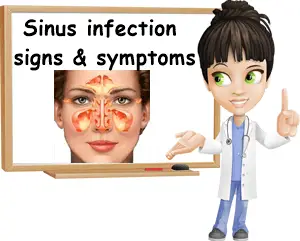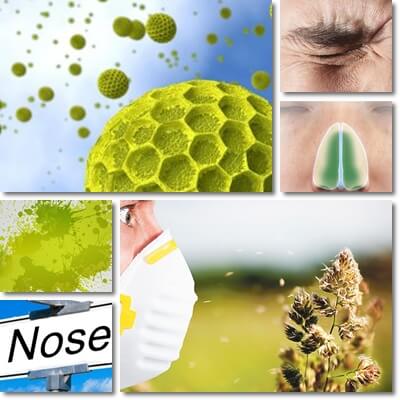A sinus infection occurs when the lining of the sinuses, the air cavities of the face near the nose, become inflamed and infected. There are three main causes of a sinus infection: viral, bacterial or fungal. However, a sinus infection can occur as a result of any type of inflammation of the sinuses, including allergies, irritants or pollution. The main symptoms of sinusitis to watch out for are tenderness, pressure or pain located in the forehead area, between the eyes in the upper part of the nose and laterally, in the cheeks area. Other telling symptoms include mucous discharge that begins as clear or white and gradually turns yellow or green, fever, cough, sore throat and loss of smell or taste. Treatment options often include management of symptoms with anti-inflammatory medication, draining the mucus, drinking plenty of fluids and, depending on the cause, antibiotics or antifungal medication.
What is a sinus infection?
By definition, a sinus infection or sinusitis refers to the inflammation of the lining of the sinuses with the possibility for infection. More exactly, inflammation and infection of the lining of the paranasal sinuses, the air cavities within the bones of the skull and near the nose. These hollow cavities connect to the nose which is why a sinus infection is considered a type of nose infection. When the mucous lining surrounding them becomes inflamed, sinusitis occurs. A sinus infection can be viral, bacterial or parasitic in nature or a result of allergies or exposure to irritants or pollution that cause inflammation. At times, it is caused by physical abnormalities of the sinuses.

Sinusitis is more than just a plain nose infection. Because it affects the hollow cavities of the skull, it creates the potential for complications such as infections affecting the brain and nervous system, ears, teeth or bones of the skull. Types of complications from sinusitis include meningitis or accumulation of infected material from the sinuses. A sinus infection can be easily mistaken for the common cold, allergies or the flu which could lead to a inappropriate treatment and increase the likelihood for complications and associated side effects.
Types of sinusitis
Duration is an important factor for identifying the type of sinusitis because it is often an indicator of the severity of the infection. How long does a sinus infection last? Anywhere between 7-10 days, 4-12 weeks and 3 months or more. According to duration, there are the following types of sinus infection:
1) Acute: lasts between 7-10 days and up to 4 weeks.
2) Subacute: lasts between 4-12 weeks.
3) Chronic: lasts for more 12 weeks/3 months.
4) Recurrent: acute sinusitis that lasts for 7-10 days and up to 4 weeks and occurs repeatedly over the course of a year.
5) Rebound sinusitis (Rhinitis medicamentosa): sinusitis caused by overuse of nasal decongestants. Can encourage an infection of bacterial, viral or fungal nature.
In addition to the duration of the infection, sinusitis can be classified according to the area affected. Any of the 4 pairs of paranasal sinuses can be affected during infection and, in the case of a more severe sinusitis (ex: chronic), more or all at once. This leads to the following classification of sinusitis:
1) Frontal: affecting the frontal sinuses located in the area right above the nose and between the eyes (in the forehead).
2) Maxillary: affecting the maxillary sinuses located below the eyes and at the sides of the nose. Can be caused by a tooth or bone infection.
3) Sphenoidal: affecting the sphenoid sinuses located in the middle part of the face, in the upper part of the nose area, between the eyes, but at the back of the nasal passages (just above the throat).
4) Ethmoidal: affecting the ethmoidal sinuses, pair of multiple smaller air cavities located in the upper part of the nose area, between the eye sockets. One group is in front and another in the back, just above the throat, like the sphenoidal sinuses.

Causes
What causes a sinus infection? The main causes of a sinusitis are viral, bacterial and, more rarely, fungal agents. In short, viruses, bacteria or fungi reach the nasal passages and, from there, the paranasal sinuses, producing inflammation of the mucous lining and subsequent infection. In response to the inflammation and infection, there is increased production of mucus which can clog the hollow cavities and worsen the sinusitis. Infections such as the common cold or the flu can lead to sinusitis as a secondary infection, either viral or bacterial in nature.
Sinusitis and allergies (allergic rhinitis). Allergies can also cause a sinus infection by creating a predisposition for it. Allergens such as plant pollen present in the nose, eyes and throat alert the immune system which triggers a host of reactions, one of which is mucus production. Excess mucus blocks the nasal passages, creating the perfect environment for opportunistic bacteria, viruses or fungal agents to multiply and produce an infection. Unless the allergy is managed to achieve thinning of the mucus and subsequent drainage, sinus infections are likely, especially in those with (multiple) seasonal allergies that affect them regularly every year or persist for weeks in a given season.
Picking your nose with dirty hands, introducing unsanitary objects into the nose, sharing nasal sprays with others, excessive nose blowing are risk factors for bacterial sinusitis. Overuse of nasal decongestants shrinks the blood vessels in the nose as well as dries the mucous lining, predisposing it to tears that can be infiltrated by pathogens. Irritants and pollution can have a similar effect and ultimately cause a sinus infection.
Examples of viruses that cause sinusitis (usually as a secondary viral infection):
1) Rhinoviruses – also source of the common cold.
2) Coronaviruses – also cause the common cold, severe acute respiratory syndrome, bronchitis, viral pneumonia, predispose to bacterial pneumonia. Coronaviruses further cause gastrointestinal disease with diarrhea, although this is not a typical symptom of sinusitis.
3) Influenza A, B and C viruses – also source of the flu.
Examples of bacteria that cause sinusitis (as both a primary and secondary infection):
1) Gram-positive bacteria: Staphylococcus aureus, Streptococcus pneumoniae etc.
2) Gram-negative bacteria: Haemophilus influenzae, Moraxella catarrhalis etc.
Examples of fungi that cause sinusitis:
1) Aspergillus fungi: Aspergillus niger, Aspergillus fumigatus, Aspergillus flavus etc.
Fungal sinusitis is most common in diabetics and anyone with immune system deficiencies (poor immunity).
Signs and symptoms
The most telling signs and symptoms of a sinus infection include headaches, dizziness, tenderness, pressure or pain in the face area (forehead, temples, between the eyes, in the cheeks, below the eyes and on the sides of the nose), earache, tooth pain, jaw ache, fever, runny nose or nasal congestion with thick, yellow or green mucus.
List of sinus infection/sinusitis symptoms:
1) Facial tenderness, pressure or pain.
Primarily affecting the forehead, area right above the nose and in between the eyes or area below the eyes (the cheeks). Worse when lying down on the back or tilting the head forward.
2) Headaches, migraines – affect the forehead, temples or, rarely, top or back of the head.
3) Toothaches, jaw ache or maxillary pain, earaches.
4) Fever – telling symptoms of a sinus infection.
5) Lightheadedness and dizziness – especially when the ear is also affected by the infection.
6) Thick, viscous yellow to green nasal discharge – telling symptom of sinusitis.
May start off as white but changes color as the infection progresses.
7) Pus from the inflammation and infection or blood from irritation or tearing may be present in the mucus.
8) Runny nose or nasal congestion from excess mucus production.
9) Post-nasal drip (being too much of it, the mucus drips down the back of the throat, especially when resting lying down).
10) Sore throat caused by the infection.
11) Bad breath.
12) Changes in taste or smell perception. Loss of taste or smell – symptom of chronic sinusitis.
13) Coughing. The cough associated with a sinus infection is likely caused by the post-nasal drip causing a tingling sensation in the throat. The cough is especially present/worse at night.
14) Malaise or a general feeling of unwell – symptom present especially in chronic sinusitis.
Treatment options
1) Treatment for viral sinusitis. Does not require antibiotics, just management of symptoms. Rest, drinking plenty of fluids to help thin mucus and drain the sinuses which also helps prevent a secondary bacterial infection. Saline solution nasal sprays can help with nasal congestion. Good hand hygiene and not overusing nasal decongestants can promote a quick recovery. If symptoms of viral sinusitis persist or worsen after 7-10 days, it may be because of a secondary bacterial infection which makes it imperative you see a doctor.
2) Treatment for bacterial sinusitis. Typically treated with antibiotics prescribed by a doctor. Should clear in 7-10 days with appropriate and immediate treatment. Symptoms of bacterial sinusitis can be managed with plenty of rest and increased fluid intake to help thin and flush out mucus, clearing the sinuses for a faster recovery. Saline solution nasal sprays can also help with congestion.
3) Treatment for fungal sinusitis. Can be acute and resolve in as little as 7-10 days with the right antifungal medication or chronic and last 2-4 weeks or more without appropriate treatment (example: fungal sinusitis can be misdiagnosed and mistaken for a viral sinusitis, especially since symptoms overlap). Again, drinking lots of fluids and resting hurry recovery. Use of saline solution nasal sprays can help clear mucus. Pain medication may be used for managing headaches and facial pain in all types of sinusitis.
4) Treatment for sinusitis caused by seasonal allergies. Consists of management of seasonal allergies. It can be done by avoiding allergens (pollen) by staying indoors on windy days, reducing time spent outside when pollen count is high, washing hair, face and changing clothes once you come from outside, keeping windows closed and using air conditioning, drinking plenty of fluids (water, unsweetened tea, sports drinks) to keep you hydrated and thin mucus in order to prevent buildup and nasal congestion that could lead to inflammation and sinusitis.
